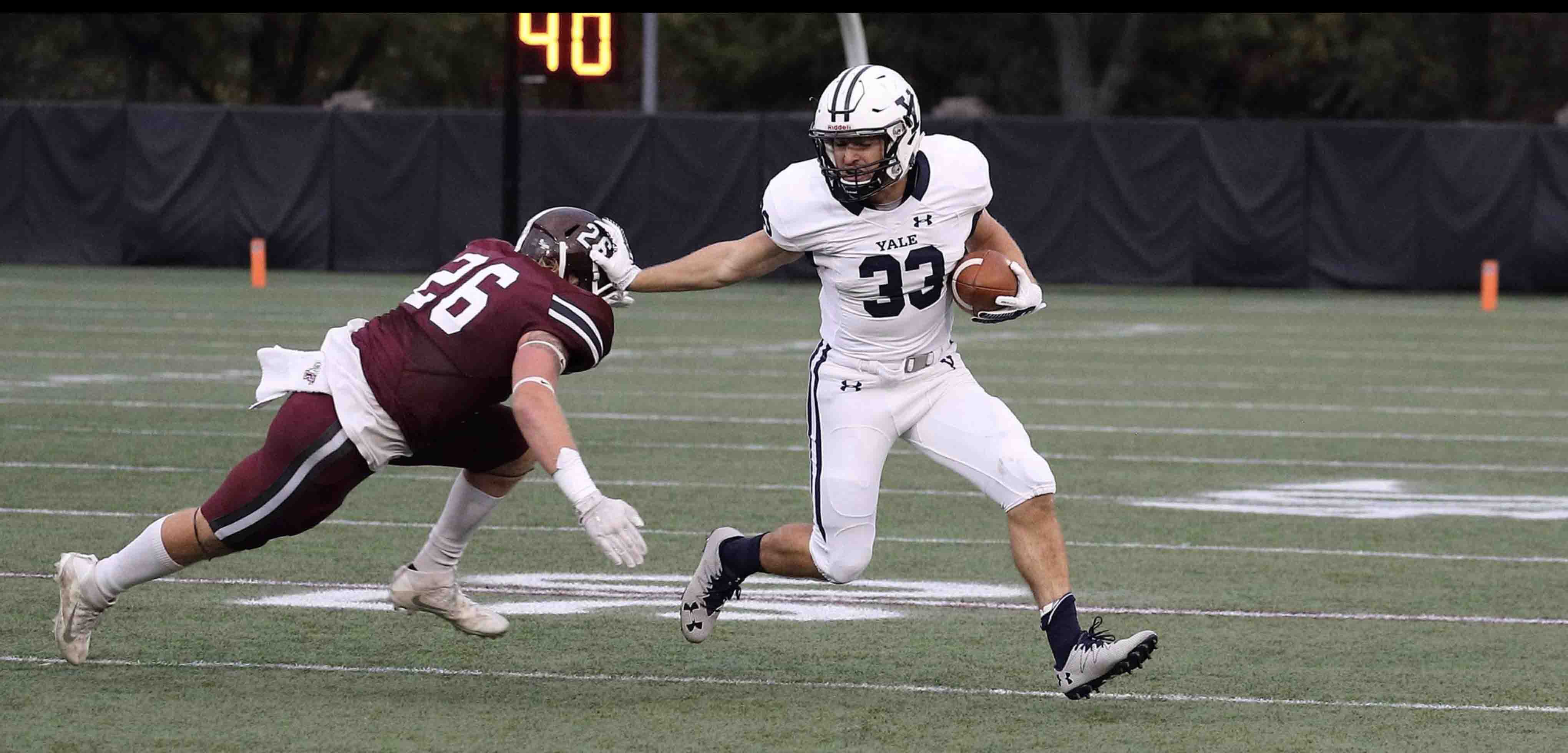
YaleAthletics
When the news broke a month ago that running back Alan Lamar ’20 had torn his ACL in a scrimmage against Brown, Yale football supporters everywhere held their collective breath. The Elis had just lost their leader from a season ago in attempts, yards and touchdowns out of the backfield.
But heading into Week 4 of the season, fans of Team 145 have exhaled. The Bulldogs have established an offensive identity predicated on running the ball. Behind a stout offensive line, Yale has averaged 7.59 yards per carry, which ranks first out of the 123 teams in the Football Championship Subdivision.
The team’s top two running backs, Deshawn Salter ’18 and Zane Dudek ’21, have complemented each other perfectly to combine for 12 of the Elis’ 21 touchdowns in the early season. Team 145’s rushing attack has faced little deterrence so far but is set to face its toughest test of the season on Saturday against a Dartmouth team that has allowed just 84.7 yards per game on the ground.
“As an offense, we’ve been looking to get better and better every week,” Dudek said. “My job has been pretty easy with our offensive line that we have and our quarterback that we have and our receivers we have. The holes that the offensive line makes for me and Deshawn back there are awesome. [Quarterback] Kurt [Rawlings ’20] gets us in what we need to get in, makes the right reads. Our receivers are out there blocking their tails off for us.”
In the wake of Lamar’s injury, Salter was expected to shoulder the rushing load for head coach Tony Reno’s offense, and he has more than delivered. The senior was an important contributor a year ago and posted a 151-yard performance in the third game of the season, only to see a lingering hamstring injury curtail his season. Upon his return, the Syracuse, New York native has been a scoring machine, finding the endzone seven times in three weeks.
Salter’s counterpart, the rookie Dudek, has been just as impressive. Months removed from his high school graduation, he exploded onto the college football scene with nine carries for 131 yards and two scores in his debut. He has not slowed down one bit in Weeks 2 and 3, as his 10.3 yards per attempt ranks second in the FCS, followed closely behind by Salter in third with 9.2 yards per carry.
The two running backs offer Reno and his coaching staff a combination of skill sets that have baffled Lehigh, Cornell and Fordham. Behind his 5-foot-10-inch, 215-pound frame, Salter has been Yale’s power back, rushing consistently for hard yards between the tackles, especially in goal-line situations. Dudek, on the other hand, has shown a shiftiness and elusiveness on the outside that has allowed him to rack up chunks of yardage after contact.
Showcasing their versatility, neither tailback has been confined to these roles. Dudek ran straight into the trenches against seven Lehigh defenders before emerging at the second level for a 29-yard touchdown. Meanwhile, Salter showed his speed after dropping 15 pounds in the offseason on an 82-yard score against the Big Red, in which he outran the entire Cornell secondary.
“[Salter and Dudek] are awesome,” Rawlings said. “They’ve sort of started taking the nickname ‘The Roaches’ because roaches never go away. It doesn’t matter who we got, I know they’re going to run hard.”
The Bulldogs’ depth and flexibility at the position have added another dimension to their offensive scheme. Rather than committing to a single workhorse running back, Yale has taken a more balanced approach, which has allowed the Elis to consistently rotate players in to limit in-game fatigue. In the three games thus far, five halfbacks have made an appearance, including Andrew Grinde ’21, who averaged 11.3 yards per carry and scored a touchdown against Lehigh. No running back has carried the ball more than 16 times in a single game.
Reno emphasized that while each running back brings his own unique skillset to the table, Yale’s offensive success is reliant on complete backs who can contribute to other elements of the offense, such as catching the ball out of the backfield or blocking in pass protection.
Although it’s still early in the season, the Bulldogs are already averaging 135 more rushing yards per game than they did in 2016. One reason for the Elis’ improved ground game is their senior-laden offensive line. Offensive tackles Jon Bezney ’18 and Karl Marback ’18 have little game experience at their respective positions, but the two have provided Rawlings with a clean pocket in 2017, allowing just one sack in the first three games. Anders Huizenga ’18, the third senior starter, has likewise provided stability from the right guard position.
Younger players, such as center Sterling Strother ’20 and guard Dieter Eiselen ’20, round out the starting unit and have bolstered an offensive attack that ranks ninth nationally in rushing yards per game. During two injury-enforced absences by starters, Lucas Tribble ’20 and Jett Sexton ’20 also filled in and contributed to Yale’s successful running game.
“One thing about that group is they work well together,” Reno said. “They’re athletic as well. We’ve got four guys that could play [offensive tackle] on that line, and that makes it easier when you’re running plays to the perimeter, getting up on guys or pass protecting. They play really well together, and they’re football guys who got a little bit of grit to them.”
Yale kicks off against Dartmouth in a battle of undefeated squads on Saturday at 1:30 p.m.
Joey Kamm | joseph.kamm@yale.edu
Won Jung | won.jung@yale.edu







